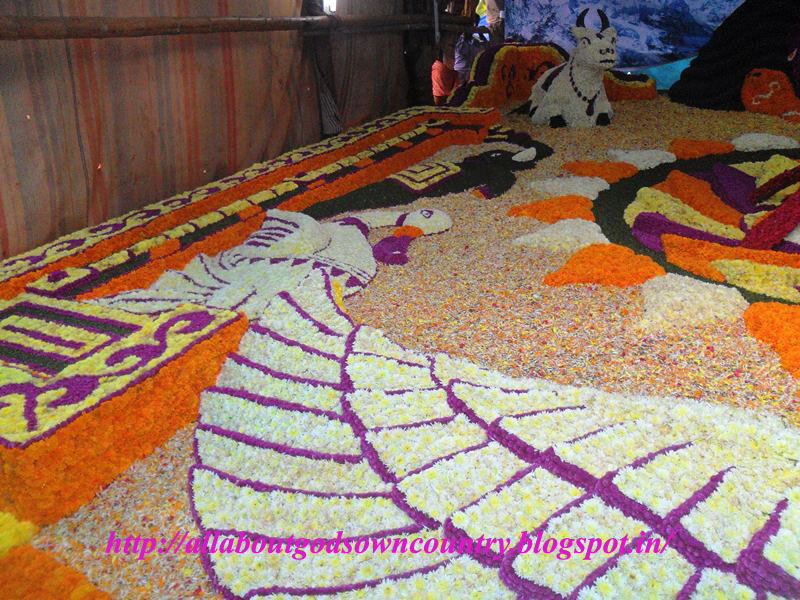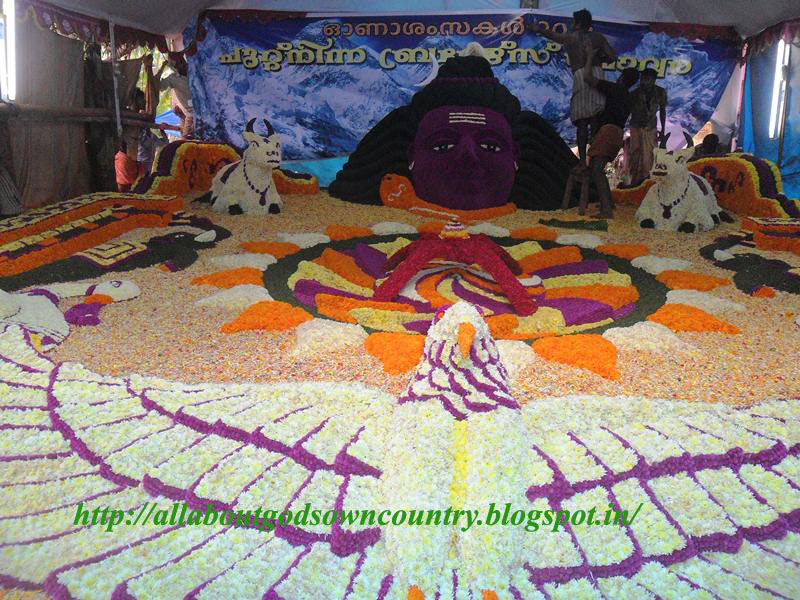The month of Chingam has arrived and season of Pookkalam (Atham) – the colourful spring on courtyards is just to begin. On the 10th day of Atham, Keralities celebrate the cheerful festival of unity and integration – Onam, irrespective of caste and creed thus propagating the messages of the festival every time. ‘Poo’ means Flowers and ‘Kalam’ means Decoration, and as it starts with Atham star of Chingam month, it is also known by the name, Athapoo. Onam month is quite nostalgic to all Keralities too, who have a lot of childhood memories associated with Onam, me too! What’s the real significance of floral decorations to welcome the season? Does Atham mark the beginning of festival season? Let us know.

Atham is an integral part of Onam celebrations
Those days have gone where each courtyard of Kerala homes used to be decorated using Athams for 10 days. Yet we have not lost all those nice moments yet, and the festival has survived through generations without losing its real fragrance and message conveyed. But it is true, now Onam is mostly celebrated by cultural organizations which promote the festival in a positive way too. It also helps a lot to promote many traditional sports like Pulikali and Kummatti Kali and customs organized during the festival season, which may have vanished years ago. Now Onam is widely celebrated in schools, colleges and offices and Athams are made using flowers, at least one day to remember our good king Maveli and welcome him. See a few visuals of atham in Thiruvananthapuram region.
Atham is related to myth and Kerala folklore
Yes, Atham is associated with Kerala folklore and Hindu mythology related to Lord Vishnu’s incarnation. So, most of its customs are linked to Hindu temples also. Yet Onam is celebrated by all Malayalis across the world irrespective of their religious beliefs. But celebrations and cultural events may slightly differ from place to place. You can read many unheard tales, beliefs and rituals related to Pookalam here. I bet you, you may not heard about them earlier.
It’s widely believed that Onam is celebrated to welcome King Mahabeli (Maveli) who visits his subjects once in every year on Thiruvonam day of first month of Malayalam calendar – Chingam. As per popular belief, Vishnu’s incarnation Vamana sent the asura king Maveli to pathala (hell), but grand him the wish to visit his subjects once in every year. Read more about full story of King Maveli.
Though Onam celebrations start with Atham day of Chingam month, celebration doesn’t end on 10th day – Thiruvonam. It lasts for two more days till Chathayam, and ends with Pulikali/Kaduvakali (Tiger Play). Apart from homes and residential associations, athams are prepared in temples and churches too. The big atham displayed at the famous Vadakkumnatha temple of Thrissur is very famous.
Athachamayam of Thrippunithura
Athachamayam which marks the beginning of Onam celebrations conducted at Thrippunithura of Ernakulam is very famous. This cultural gala is widely organized on Atham day and is a spectacular sight of cultural Kerala. Almost all folk and dance items of Kerala are displayed along with colourful floats and caparisoned elephants in the procession and it also mark the victory of Kochi King. Started in those majestic days of king’s rule, this customary procession is conducted every year as a part of Onam celebrations, and to promote folk and traditional art forms linked with Kerala culture. Read more about Pulikali of Thrissur.
When was Onam and Athapoo decorations started?
Though there are no clear evidences when this festival started, it’s believed to be started in around 800 AD. There are records of Onam celebrations during the reign of Kulasekhara Perumal in the 8th century, and so there are possibilities that Onam celebrations might have started earlier. However the celebration during Kulasekhara Perumal’s rule is the earliest evidence available. So it can be assumed that preparing pookkalams too might have started during that period.
Uthra Kumbilappam
Small cucumber (Kani Vellari) is the star of Vishu season. But pumpkin and ash gourds are the stars of Onam season. There used to be a special custom conducted every year just before Thiruvonam celebration. Now such sights are rare to see. On Uthram star day, a pumpkin will be placed on a stool (peedam in Malayalam) in the courtyard of the house. It will be placed in north-south direction and the elder male member of the family (Karanavar) cut it into two halves, with eyes closed.
If the ivy guard is exactly cut into two halves, it’s good omen. If left piece is small, wealth is the after effect. If it’s big, death is the consequence. If ivy guard crushes, accident is the consequence. That’s the prediction. Later exactly the same space is smeared using cow dung solution and used to prepare Pookkalam for next 10 days. Read a few more rules and customs related to Pookalam making, which have virtually faded from scene.
Onam flowers associated with the season
Though there are no clear definitions for the flowers to be used for making athams, in those glorious old days, some of the flowers formed an integral part of pookkalam. Nowadays many of them are not easily available, and people use flowers of their choice to prepare pookalam.

Among all flowers used for pookkalam, white leucas (thumpa poo) has great significance. But nowadays this pure white flower is very rarely used in pookkalams. As green paddies and courtyards are vanishing, so are white lucas too, which was once an integral part of Kerala culture. Flowers of Kumbalam (white gourd), Kolambi poo, Thumba (leucas), Karuka, Kalyanasougandhingam, Arali (Nerium), Mukkutti, Kaithonni, Thiruthali, Thechi/Thetti (ixora), Odinjukuthi, Hanuman Kireedom, Aripoo, Uzhinja, Kayambu, Kaakkapoov, Poovankurunnu, Nilappana, Mathan (pumpkin), Kannanthali and chembarathi (hibiscus/shoe flower) are listed as Onapookkal (flowers of Onam).
Any Rules associated with preparing Pookkalam?
Pookkalam are usually prepared in the early mornings, and it is to be made on 10 days – from Atham star to Thiruvonam star, that means till Onam. If any star of those 10 repeats in Malayalam calendar, then pookkalam will be done for 11 days. In some rare cases, it may end up in 9 days too, if two stars happen to fall on a single day. Usually circular cone shaped and multi-tier attams are made using mud or clay, with steps in odd number, say 1, 3, 5, 7, 9 etc, and placed exactly in front of the main door in the courtyard. It is usually prepared one or two days prior to Atham day.

Usually cultural events and Onam sports like kaduvakali (Tiger and hunter) and Thumbi thullal are associated with Thiruvonam day celebrations and atham displays. As per tradition, Atham remains untouched for 15 days, and on Ayilyam star, i.e the 15th day it is decorated once again and on the next day, Makam the atham is given a cut at four sides using a knife to mark the end of cheerful Onam celebrations. But such celebrations are rarely seen nowadays, and people end atham decorations by Thiruvonam day itself.
In old days, pookkalams made of mud make use of diluted cow dung on athams so that flowers can be easily stick on to it. People also sprinkled cow dung water in the courtyard after cleaning, in those days. Such sights are rare nowadays. In present century ‘mud attams’ have been replaced by simple floral decorations due to lack of space available in apartments and flats in towns and cities. In well-concreted courtyards who would prefer to sprinkle cow dung! But such traditions still prevail in rural areas and remote villages, though very rare.
Disappearing sights of Pookoodas and Poovilikal
In old days, children used to wake up early in the morning to collect flowers for Pookkalams. Such sights have disappeared even from remote villages now. They travel in group and used to carry a basket called Pookooda in local terms, to collect flowers from nearby houses, small streams, paddy fields etc. They used to sing Onam songs called Poovilikal while collecting flowers.
Nowadays courtyards, green fields and water bodies are disappearing and students have huge burden of studies and tuition classes, and so need to buy flowers from markets to fill their pookkalams. This easy way can never bring the happiness of those nostalgic poovilikal which was quite common quarter-a-century ago.
Adding one colour each per day
As per rules, on the first day, only a single colour is used on commence of Onam, and each day one colour is added till it reaches 10 colours on Thiruvonam day. Usually start off with simple thumpa poo (white) on first day, adding colours as each day pass by. At centre a nice and attractive flower is placed. In Malabar and Thrissur regions, Onathappan is worshipped and placed on Attam on 9th or Thiruvonam day. Such practices are less seen in south Kerala.

Onathappam of Onam
In some regions, there are choices of flowers also, and people often add different colours to salt and decorate them as flowers, which is not at all encouraged while preparing traditional athams. Scrapped coconut may be used as an alternative of white colour. But atham made using salt or coconut will be disqualified for atham competitions.
Atham competitions during Onam season
Apart from cultural events conducted in associations and working offices, pookkalams are also prepared as a part of competitions in clubs, schools and colleges also. In most cases, there are heavy competitions between residential associations on Thiruvonam day. No doubt this floral carpet is a visual treat to our eyes and a testimony of religious harmony.
There are many factors taken into consideration during atham competitions. Only flowers, grass and leaves can be used to decorate athams. Colour pattern, design and proportionally are the major factors of great importance. Irregular edges, piths and crests and bad colour combination can give negative marks. Creativity, neatness and uniqueness can add more marks if you are a part of a competition. Usually during such competitions which have a limited time period, the contestants would already plan a design, and decide which colours and flowers are to be filled in each column.
A traditional Kerala lamp (deepam), pooja for Ganapathi (by placing cow dung, flowers, aval-pori (a form of rice used for poojas), banana bunches and agarbattis on a plantain leaf), Onathappan, Tulsi (Basil) leaves etc are distinct fingerprints of a traditional Kerala atham. Very often bronze medal filled with rice is also placed with a coconut flower bunch. Nowadays technology is also used to make nice floral designs. Now it’s the age of multi-dimensional and geometrical patterns created by professional designers.
Floral decorations at Kovalam belt are very famous
To promote tourism, Onam celebrations are widely conducted in state capital with lighting festivals, cultural shows, live programs etc. So, Kovalam – one of the best tourist locations of Kerala also make this occasion grand. Huge athams are prepared in this belt which may cost in lakhs, and each one belongs to clubs and associations. For the first nine days they make simple athams to keep tradition, and on the last day they plan it something big. On Thiruvonam day there is competition between associations and each one spend lakhs of money to cheer the occasion with colourful display of pookalams.
Big planning is done to keep the competitions alive. On the Uthradam day (9th day) morning itself, they cover the site with plastic sheets and tents to cover the sight. Then more than 20-30 men work together for long 24 hours without sleep to prepare atham for the most auspicious Thiruvonam day. They make great sculptures out of clay, mostly related to Hindu tradition, festivals or deities and later decorate using flowers.
 Kilos and Kilos of flowers and leaves may be needed to decorate athams of Kovalam-Vizhinjam belt. They choose colourful flowers like jamanthi (marigold/chameli), chrysanthemum, vadamalli/chendumalli (Bachelor’s Button), pine leaves etc which won’t fade easily. As competition of pookalams is huge, large quantities of flowers are imported from neighbouring states to Kerala during Onam season. Definitely it’s the harvest festival and spring season of Keralites, soon after heavy monsoons.
Kilos and Kilos of flowers and leaves may be needed to decorate athams of Kovalam-Vizhinjam belt. They choose colourful flowers like jamanthi (marigold/chameli), chrysanthemum, vadamalli/chendumalli (Bachelor’s Button), pine leaves etc which won’t fade easily. As competition of pookalams is huge, large quantities of flowers are imported from neighbouring states to Kerala during Onam season. Definitely it’s the harvest festival and spring season of Keralites, soon after heavy monsoons.
Winners get trophy and huge prize money too. But it’s sad, no: of competitors have decreased over the years, and reduced to almost half in the past 10 years since I have seen athams in this belt for the first time. It’s a spectacular sight to see huge folk of foreigners and TV channel representatives to see pookalams on Onam day. The organizers also ask for small amounts from the spectators to cover the expenses. See a few floral decorations at Kovalam belt.
Other parts of the world known for Pookkalams
In India, Kerala might be the only place where floral decorations for 10 days become an integral part of a regional festival. Brazil, Italy, Thailand and Belgium are other parts of the world where such floral decorations are made. Italians decorate their city with daffodils in July-August, and it’s almost the same time of occasion of Onam festival in Kerala. Flower festivals are conducted at Brazil and Belgium too, which attract tourists as well.
Thai people’s New Year festival is similar to Onam. Apart from making colourful pookkalams, they also wear new clothes and prepares grand feast. Onam too is celebrated in the first month as per Malayalam calendar.
Conclusion
Pookkalams – which may fade in the evening has a lot of efforts by a lot of people. Making designs, collecting flowers and preparing pookalams as a group definitely gives messages of harmony and unity. That’s what festivals irrespective of religions, are really meant about!
Go through the gallery to read a few more interesting articles on fun, recreation, myths and traditions associated with Onam season. Here is the page link. Click on the images to read.



 Kilos and Kilos of flowers and leaves may be needed to decorate athams of Kovalam-Vizhinjam belt. They choose colourful flowers like jamanthi (marigold/chameli), chrysanthemum, vadamalli/chendumalli (Bachelor’s Button), pine leaves etc which won’t fade easily. As competition of pookalams is huge, large quantities of flowers are imported from neighbouring states to Kerala during Onam season. Definitely it’s the harvest festival and spring season of Keralites, soon after heavy monsoons.
Kilos and Kilos of flowers and leaves may be needed to decorate athams of Kovalam-Vizhinjam belt. They choose colourful flowers like jamanthi (marigold/chameli), chrysanthemum, vadamalli/chendumalli (Bachelor’s Button), pine leaves etc which won’t fade easily. As competition of pookalams is huge, large quantities of flowers are imported from neighbouring states to Kerala during Onam season. Definitely it’s the harvest festival and spring season of Keralites, soon after heavy monsoons. 















Recent Comments